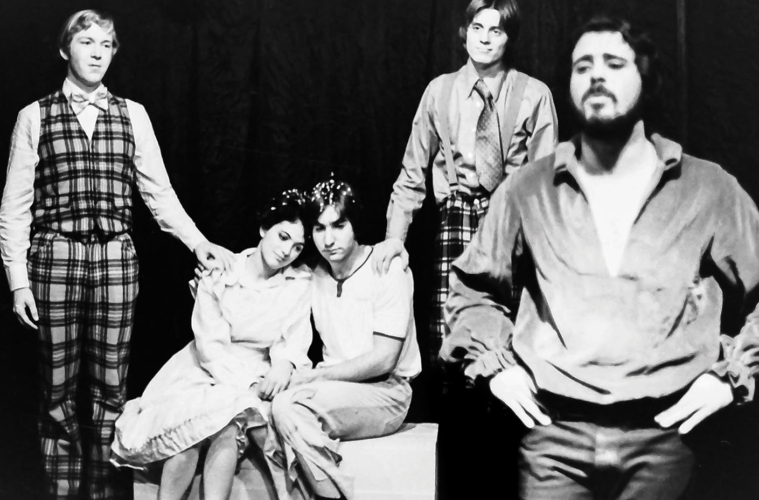With the opening of the Dana Arts Center in 1966, Colgate finally had a much-needed home for theater performances. However, those in charge of University Theater determined what was presented on the Brehmer Theater stage and did not think musicals warranted serious attention.
In the fall of 1973, a group of us from The Colgate Thirteen decided it was time to break the mold: We would put on a musical for our 1974 January Plan. [For those who are unfamiliar with “Jan Plan,” during January, there were no classes, so students had the opportunity to work on a special, monthlong project.] Knowing time and resources would be limited, we chose the elegantly and elementally simple The Fantasticks, an eternal tale of children, parents, and coming of age — then and still the record holder for the longest-running musical in the world.
We needed a sponsor, but the head of University Theater was unwilling. Luckily, music professor Dexter Morrill ’60 agreed to sign off on the project. Needing a venue, we approached University Chaplain R.V. Smith to ask if we could use The Agora, a gathering place in the basement of the chapel. With relatively low ceilings, no lighting equipment, and no stage — well, Broadway it wasn’t. He readily agreed.
As soon as we returned to campus in January after winter break, we scrambled to create a performance space. Ned Hitchcock, the designer for the University Theater, gave us a spare platform and a couple of poles we could use for lights and to hang the minimal scenery: the opening drape with The Fantasticks emblazoned on it; a cardboard circle, one side painted with a quarter moon, the other with a bright yellow sun; a bench; and a chair.



Rob Colby ’77; Ward (L) and Duffy; Rob Michalak ’77 (R)
The company was made up of: Clint Clifford ’74 as The Narrator; Daniel Mason ’75 as The Boy; Gay Gordon ’76 as The Girl; Bruce Ward ’75 as The Boy’s Father; me as The Girl’s Father; Robert Colby ’77 as The Mute; Bruce Dubois ’75 as The Old Actor; and Rob Michalak ’77 as The Man Who Dies. Joining us were two pianists, Bruce Levkoff ’76 and Christine Sholes ’77; percussionist Fred Kaplan ’74; and Robert Anderberg ’77 on bass. Jonathan Slater ’77 did the lighting. I directed, and Colby devised the choreography.
We began rehearsals right away, learning songs, dialogue, and stage directions, as well as creating our costumes and makeup. We put up mimeographed flyers around the campus announcing the show (and the grand admission price of 50 cents). We worked every day straight through until the last week of January when we gave four performances.
To our delight, every night was standing room only. And to our even greater delight, audiences erupted in cheering applause and standing ovations after each show. That impressive response prompted Dean of Students Guy Martin ’57, MA’59 to ask if we could mount the show again for four performances during the first week of spring semester so more people could see it. We did, and perhaps because of word of mouth, the reception was even more enthusiastic.
As a writer for the Colgate News put it, “The Fantasticks was undertaken as a January project by 11 students who have all passed with flying colors.” (By Colgate coincidence, the actual number of people involved was … 13.)
All this prompted calls for more variety in campus theater offerings, which eventually happened. In 1977, Colby, armed with the undeniable success of The Fantasticks, convinced the University Theater to help with a show he directed, You’re A Good Man, Charlie Brown. And this is how musical theater came to Colgate.

A recent cast reunion (L to R) Duffy, Michalak, Mason, Colby, Clifford
Malachy Duffy ’74 spent his career as a journalist working at and writing for magazines such as Travel & Leisure, Food & Wine, Bon Appetit, Town & Country, Bloomberg Personal Finance, and many more. He’s been a regular theatergoer since he was 12 years old. Last year, Duffy opened a box containing his Colgate memorabilia, including a folder on The Fantasticks.

